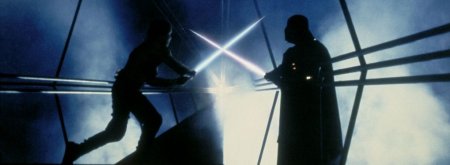The Shawshank Redemption
The Shawshank Redemption has earned a reputation for being one of the most popular films of all time. Despite an unimpressive performance in the cinema box-office, it regularly tops ‘most popular movies’ votes. Tim Robbins said of the film: ‘Why has it endured? ... The reason why it’s had a profound impact on people has a lot to do, I think, with its spirit, and the hope within it. The idea that over a long period of time, someone’s ambitions can come true, that resilience and persistence pay off.’[1]
Hope in a Grey Place
The film tells the story of Andy Dufresne (Tim Robbins), a young city banker sentenced to life imprisonment in Shawshank Prison in 1947 for the murder of his wife and her lover. The film charts his friendship with ‘Red’ (Morgan Freeman), a cynical prison black-market dealer, who takes an initial dislike to Andy, but gradually grows to respect and admire him. From Red, Andy learns about what life inside Shawshank is like, but he also experiences horrendous (off-camera) abuse from a group of other prisoners. He earns the trust of the guards, and eventually the corrupt Warden Norton, when he proves invaluable in dealing with their tax returns and other financial problems.
Warning: this article contains significant plot spoilers
One of the film’s key turning points comes when a new convict, Tommy (Gil Bellows), is brought to the prison. Tommy claims to have served time before with the criminal who actually killed Andy’s wife and her lover, and Andy faces the possibility that Tommy’s testimony could lead to his release. This hope is dashed, however, when the warden, unwilling to part with his pet financial advisor, arranges to have Tommy killed.
The Shawshank Redemption does an impressive job of conveying the effect of long prison sentences, which Red calls institutionalisation. He comments, ‘These walls are kind of funny. First you hate 'em, then you get used to 'em. Enough time passes, gets so you depend on them. That's institutionalised. They send you here for life; that's exactly what they take. The part that counts, anyways.’ It is here that we see the difference between Andy Dufresne and the other inmates: while others become resigned to life inside, Andy never allows his spirit to be confined by the walls surrounding him. Even at the beginning of his term he seems confident and self-assured, and as time goes on this quiet confidence begins to show more clearly in the striking and inspiring actions that he takes.
The Shawshank Redemption makes it clear that Andy’s influence saves Red. Andy’s sense of inner peace and hopefulness powerfully affect him, inspiring him to make a spirited and defiant pronouncement at his parole hearing, which leads (perhaps a little improbably) to his release. But what happens after Red is released is even more telling. The film shows his life on the outside, clearly following in the footsteps of Brooks, a prisoner released some time before him. Brooks had been so institutionalized that he threatened to kill another prisoner rather than be released on parole, and his sad life outside prison in a world he no longer knows or understands ends in his suicide. Red follows just the same pattern, working in the same store and living in the same apartment. But instead of killing himself, he takes the lifeline offered by Andy before his escape: he breaks his parole and goes to find his friend in the Mexican city of Zihuatanejo.
It is interesting that Andy’s source of hope, which keeps his spirit buoyant in spite of his horrible surroundings, is never explicitly explained, and thus it is left to viewers to make their own judgments. It may be based solely in the secret he hides behind the poster in his room; the knowledge that little by little he is getting closer to escape. But the explanation that Andy’s indefatigable spirit is grounded simply in his belief that he will eventually escape is, I believe, insufficient. The film suggests he has some deeper peace, which allows him to continue to hope in spite of the guard’s threats, his hideous treatment at the hands of the other prisoners and, indeed, the fact of his wrongful imprisonment in the first place. Yet the film never says what this is.
The Bible talks about hope in the book of Romans, where Paul says that Christians should ground their hope in God. This is hope in something concrete, not merely wishful thinking that something will or won’t happen, like hoping to win the lottery or hoping it won’t rain tomorrow. When the Bible says, ‘hope will not lead to disappointment’ (Romans 5:5) it evidently does not mean hope in that way, because people clearly do hope for many things which do not happen. Instead, true hope is certain, because it is based on the promises of God. As Paul says later on in the same book, ‘we look forward to something we don’t yet have’ (Romans 8:25), but we know that it will come because the person who promises it, God, is trustworthy and will not let us down. And so we can carry hope with us: the hope that, no matter what is going on in our lives, God is ultimately in charge and will help us through, and that in the end we will go to a better place.
I’m inclined to agree with Tim Robbins in his assessment of why The Shawshank Redemption is so popular. It is very attractive and moving to see persistence and resilience pay off over a long time. More than that, though, the film shows that Andy’s hope pays off, and that is something that we appreciate. Throughout his incarceration, Andy carries his hope with him, and it prevents him from being ground down by the drudgery of life in Shawshank Prison. We can find much the same in real life. The daily grind of work or the pressure of difficult situations threatens to quench our spirit, but God offers us the hope that, if we put our trust in him, we can have true and realistic hope that will carry us through: the knowledge that, one day, we will be free of the troubles of this world altogether.
 Film title: The Shawshank Redemption
Film title: The Shawshank Redemption
Keywords: Hope, despair, freedom, imprisonment, salvation
Tagline(s): Fear can hold you prisoner. Hope can set you free.
Director: Frank Darabont
Screenplay: Frank Darabont, based on 'Rita Hayworth and Shawshank Redemption', a short story by Stephen King
Starring: Tim Robbins, Morgan Freeman, Bob Gunton, William Sadler, Clancy Brown, Gil Bellows
Distributor: Castle Rock Entertainment and Columbia Pictures
Cinema Release Date: February 1995
Certificate: 15
Buy from Amazon.co.uk or from Amazon.com
References
[1] Empire, issue 201, March 2006, ‘201 Greatest Films of all time’
© 2009 Steve Alexander



